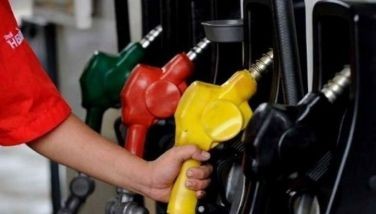GMA orders plans for naphtha cracker plant revived
August 8, 2004 | 12:00am
President Arroyo has ordered the PNOC-Petrochemical Development Corp. (PPDC) to revisit plans of putting up the first naphtha cracker plant in the country.
"PPDC will be given a key role in the petrochemical industry and eventually expected to put up the naphtha cracker plant," the Chief Executive said over the weekend.
Officials said that a review of plans to put up the $1.2-billion naphtha cracker plant in Bataan is now feasible after groups of new investors decided to enter into the petrochemical industry.
"Maybe it would be appropriate if we will be able to revive our plans to construct the naphtha cracker plant and make our efforts in full swing now that the Metro Alliance group decided to operate the BPC (Bataan Polyethylene Corp.)," Philippine National Oil Co. (PNOC) president Thelmo Cunanan said.
Cunanan said with the entry of new investors in BPC, three big petrochemical groups would now be operating within the PPDC-run petrochemical park.
"Petrocorp and Philippine Resins Industries Inc. and BPC may be likely clients of the naphtha plant," he said.
PNOC and PPDC have been scouting for potential joint venture partners for the naphtha project, which will be located in PPDC’s 530-hectare petrochemical park in Bataan.
Early this year, Petronas and British Petroleum Plc. (BP) pulled out of the Bataan Polyethylene Corp. (BPC) consortium, prompting the PNOC to re-evaluate the naphtha project’s viability.
The naphtha cracker plant, with an expected capacity of between 450,000 and 600,000 metric tons a year, will manufacture raw materials needed to make plastic products. Without the cracker facility, the country remains dependent on imported raw materials for the petrochemical industry.
The recommended plant capacity for the first phase is 450,000 tons of ethylene per year with provisions for debottlenecking to 600,000 tons per year after three years from commercial operation.
The cracker plant project, being the first of its kind in the Philippines, is expected to spur growth in the petrochemical sector. With the huge potential for growth of the consumption of plastic resins, the Philippines, at 5.2 kilograms per capita, is seen as a good place to invest in petrochemicals. The average per capita consumption in the Asean sub-region stands at 10.2 kg.
Petrochemicals are organic compounds derived from petroleum raw materials (called naphtha) or natural gas or a derivative produced from such a substance by chemical reaction, e.g., ammonia, carbon black and thousands of organic chemicals. Petrochemicals are commonly referred to a plastics or synthetic resins.
Aside from PPDC, President Arroyo also took note of the other roles that the other PNOC subsidiaries will have to fulfill as part of her administration’s effort to improve energy efficiency and independence as well as gain savings from these endeavors.
She has also directed PNOC-Energy Development Corp., the geothermal development arm of PNOC, to forge alliances with international investors in developing geothermal fields in the country.
She added that PNOC-Exploration Corp., on the other hand, should also be able to maximize efforts in oil and gas development.
These, she said, will enable the country to lessen its dependence on imported oil and make use of indigenous and clean sources of energy.
"PPDC will be given a key role in the petrochemical industry and eventually expected to put up the naphtha cracker plant," the Chief Executive said over the weekend.
Officials said that a review of plans to put up the $1.2-billion naphtha cracker plant in Bataan is now feasible after groups of new investors decided to enter into the petrochemical industry.
"Maybe it would be appropriate if we will be able to revive our plans to construct the naphtha cracker plant and make our efforts in full swing now that the Metro Alliance group decided to operate the BPC (Bataan Polyethylene Corp.)," Philippine National Oil Co. (PNOC) president Thelmo Cunanan said.
Cunanan said with the entry of new investors in BPC, three big petrochemical groups would now be operating within the PPDC-run petrochemical park.
"Petrocorp and Philippine Resins Industries Inc. and BPC may be likely clients of the naphtha plant," he said.
PNOC and PPDC have been scouting for potential joint venture partners for the naphtha project, which will be located in PPDC’s 530-hectare petrochemical park in Bataan.
Early this year, Petronas and British Petroleum Plc. (BP) pulled out of the Bataan Polyethylene Corp. (BPC) consortium, prompting the PNOC to re-evaluate the naphtha project’s viability.
The naphtha cracker plant, with an expected capacity of between 450,000 and 600,000 metric tons a year, will manufacture raw materials needed to make plastic products. Without the cracker facility, the country remains dependent on imported raw materials for the petrochemical industry.
The recommended plant capacity for the first phase is 450,000 tons of ethylene per year with provisions for debottlenecking to 600,000 tons per year after three years from commercial operation.
The cracker plant project, being the first of its kind in the Philippines, is expected to spur growth in the petrochemical sector. With the huge potential for growth of the consumption of plastic resins, the Philippines, at 5.2 kilograms per capita, is seen as a good place to invest in petrochemicals. The average per capita consumption in the Asean sub-region stands at 10.2 kg.
Petrochemicals are organic compounds derived from petroleum raw materials (called naphtha) or natural gas or a derivative produced from such a substance by chemical reaction, e.g., ammonia, carbon black and thousands of organic chemicals. Petrochemicals are commonly referred to a plastics or synthetic resins.
Aside from PPDC, President Arroyo also took note of the other roles that the other PNOC subsidiaries will have to fulfill as part of her administration’s effort to improve energy efficiency and independence as well as gain savings from these endeavors.
She has also directed PNOC-Energy Development Corp., the geothermal development arm of PNOC, to forge alliances with international investors in developing geothermal fields in the country.
She added that PNOC-Exploration Corp., on the other hand, should also be able to maximize efforts in oil and gas development.
These, she said, will enable the country to lessen its dependence on imported oil and make use of indigenous and clean sources of energy.
BrandSpace Articles
<
>
- Latest
- Trending
Trending
Latest
Trending
Latest
Recommended























